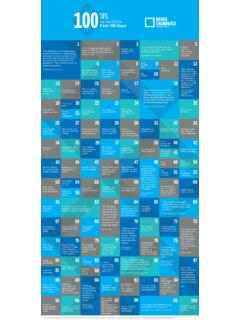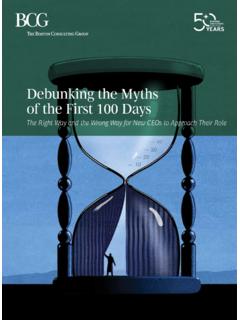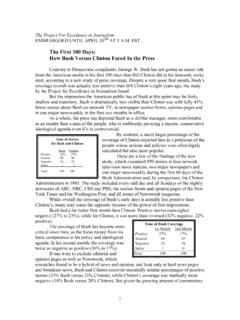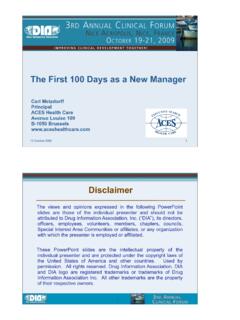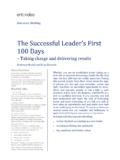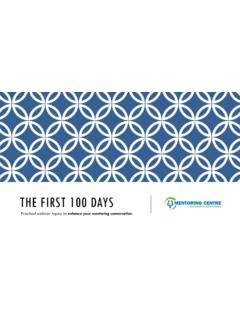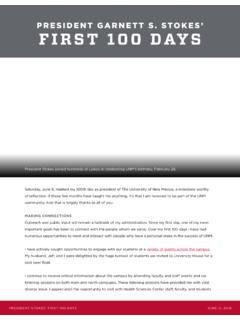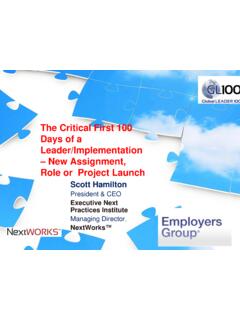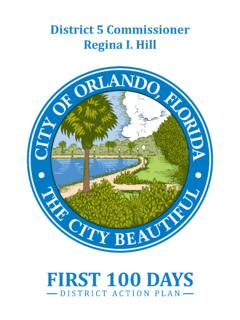Transcription of COMMUNICATIONS OFFICERS FIRST 100 DAYS - Weber …
1 CHIEF COMMUNICATIONS OFFICERSFIRST 100 DAYSCHIEF COMMUNICATIONS OFFICERSFIRST 100 days Chief COMMUNICATIONS OFFICERS : FIRST 100 days is Weber Shandwick s second mini-book in its Thought Leadership series. Companies of all types, sizes and regions are facing unprecedented and complex COMMUNICATIONS challenges. The chief COMMUNICATIONS officer (CCO) is fast becoming a significant member of the executive team as globalization melts borders, new media accelerates missteps, and crises topple our finest re all t ype A personalities, but that can be your downfall in the f irst year. You neeD To Slow Down AnD geT AlIgneD wITh The culTuRe, vISIon, STRATegY AnD objecTIveS oF The new oRgAnIzATIon beFoRe You cAn mAke AnY ASSumpTIonS on chAngeS oR t compare to your old organization embrace your new group fully and get ready to change your perspective.
2 This book is a compilation of tips and anecdotes volunteered by veteran CCOs around the world. In their own words, CCOs reveal lessons learned early in their tenure. They share if I could do it over laments, likely challenges for newcomers and, importantly, invaluable advice for a smooth FIRST 100 hope this mini-book serves as a helpful guide for new corporate COMMUNICATIONS professionals taking a seat at the table and is an enjoyable reflection for veteran CCOs who have been in their seat for some you to all the busy CCOs around the world who took the time to provide us with valuable pATIenT Lesson 01:Lesson 01you havemoRe ThAn100 : The Rising CCO II conducted with Spencer Stuart and KRC Research To pRove monThS, CCOs say they have on average, PRePARe before YOU cAn T dO enOUgh Due DIlIgence. The toughest and most vital information to find about a prospective job isn t available online.
3 You must figure out what kind of behavior is valued, how the senior team interacts, what the CEO demands of direct reports, why the previous COMMUNICATIONS VP failed, and what the political landscape is like. Lesson 02(Don Spetner, Executive Vice President, Corporate Affairs, Korn/Ferry International)lISTen &leARn( and appreciate what was already done ).Lesson 03 The f irst 30/60/90 days are all about listening and learning. By Day 100, a strategic plan is forming. Don t make people come to you. Meet them on their turf. Ask the same questions over and over so you start to get a picture of the diversity of views/opinions on the same subject. Lesson 04exPecT TO mAke chAngeS and FIll keY AlUATe YOUR TeAmf romDAY s no consensus on how long it should take to assess the skills of your new team CCOs report anywhere from 30 days to one year!
4 Make the necessary changesSooneR rather than lATeR . leT Them venT and listen to their issues. compleTe 1:1 meeTIngS with each direct report. TAke The TIme To meeT YouR TeAm which can be dispersed all over Asia. gAIn TheIR ReSpecT by involving them in the transformation. ReoRgAnIze AFTeR you get to know the key players in management. Lesson 05 Don T cRITIcIze your predecessor. Understand the COMMUNICATIONS activities conducted over the past three years. Keep an open mind towards change, no two companies share the same COMMUNICATIONS strategy. Acknowledge the good work already being done. By too urgently showing folks what you know, you can alienate key people. JudiciouslyReFeR To how You DID ThIngSat your previous you will quickly become a doer reacting to the necessary ebb and flow of business rather than the change agent they hired you to be.
5 BuIlD An AgenDA ThAT You cAn DRIve, Lesson 06 Source: The Rising CCO II conducted with Spencer Stuart and KRC ResearchGet to know the buSIneSS of CCOs wiSh TheY hAd SPenT mORe Time wiTh The buSIneSS unITS during their early tenure. Attend monthly business unit meetings. Ask, Tell me about my team. Meet individually with business unit leaders and let them talk as much as possible. Take lots of notes and thank them for their time. AuDIT vIewSof business unit & functional leaders on COMMUNICATIONS . Lesson 07 DevelopInTeRnAl ADvocATeS both professional & new organizational relationships is the #1 AcTIonCCOs take during their FIRST six : The Rising CCO II conducted with Spencer Stuart and KRC ResearchIT DoeSn T mATTeR how gooD YouR IDeAS ARe if you don t have a constituency. Find one initiative where you can achieve a good, quick result to geT people on YouR SIDe.
6 BUild A conSTIT uencY across the enterprise. Lesson 08 Identify internal leaders with real influence and meet with them over lunch or dinner ThAT S when people open up. Find out as much as you can about the internal power structures. who hAS InFluence on whAT kInD oF ISSue? Once you know The InTeRnAl STRucTuReS, you have a much faster grip on everything and can position yourself more confidently. Your peers ARe wATchIng You. They know what they need most from your function. Figure out the ShADow oRgAnIzATIon. Lesson 09 Don T loSe SIghT of what s outside the organization. Become familiar with reporters. Get to know/understand customers. One tends to see things from an internal point of view. Look at things 80% from outside of the company. Conduct an external audit of key stakeholders regarding the company s reputation.
7 Lesson 10be pRepAReD for someThe job is close to what you thought it would noT enTIRelY. On a scale of 1 to 10where 1 is not at all different and 10 is extremely different from what he/she initially expected,The AveRAge cco RATeS hIS oR heR SuRpRISe level 4, suggesting fairly well-prepared of understanding on how strategic COMMUNICATIONS can help drive business success globally. How the skills of many long-time employees had atrophied. Very low understanding (and regard) for the business role the Corporate Affairs department could play. Little support for the region. Lack of collaboration with other functions. It takes time to win confidence in China of peers and people reporting to you. Difficulty of getting other communicators to cooperate when they report outside your organization. The level of legal intervention.
8 WhAT wAS YouR bIggeST SuRpRISe DuRIng YouR FIRST 100 days ?Lesson 11 Gain the CEO a business plan during those FIRST 100 days and ask the CEO if it aligns with company serve at the pleasure of your CEO. Understand how he/she prefers to receive counsel (especially pushback). Ask your CEO for names of five people outside your team to meet early on. Work towards a quarterly strategic plan. Agree on a timeline with your CEO. Most CCOs say that the CEO was their best mentor in their early months starting out. CEOs are looking for leaders and strategic thinkers in this function; people with vision and strong execution skills. It s important to be seen simultaneously as a SOURce Of unIque peRSpecTIve On The execUTive TeAm A well-ORgAnized leAdeR whO cAn DelIveR TAngIble ReSulTS. (George Jamison III, Corporate COMMUNICATIONS Practice Leader, Spencer Stuart) & Lesson 12 What were YouRS?
9 Find your eARlY weRe YouR eARlY wInS?communIcATIng The new ceo S vISIon for the organization. Shape understanding at a senior level as to whAT gooD lookS lIke. SoRT ThRough a demoralized staff. A newS ITem on national news on day three. DeFInIng RoleS and responsibilities. Coordination of InTeRnAl COMMUNICATIONS . A keY meSSAge DocumenT for the coming year a company FIRST ! Development of a DepARTmenTAl plAn. Assessing bRAnD heAlTh. Focus on SocIAl meDIA practices. As simple as launching an InTeRnAl COMMUNICATIONS pRAcTIce consisting of a pan-Asian e-newsletter and AP corporate intranet. What are the gReATeST chAllengeS facing new CCOs?ClosingRemarks:Building credibility for the function. Knowing where and when to push and where and when to be patient. Being seen as a business driver. New media. Assimilating rapidly into a new culture.
10 Deciphering my CEO s vision. 24-hour news cycle. Building and protecting reputation. You are a cost-center, not a revenue-producer. Thinking you have already proven yourself. Manage NIH (not invented here) locations how do you win them over? Measurement. Maintaining your stamina. whAT ARe The gReATeST chAllengeS FAcIng new ccoS? The ThRee gReATeST chAllengeS facing new CCOs areRepuTATIon mAnAgemenT in an era of deterioration of traditional media, IncReASIng eFFecTIveneSS of voices of ouTRAge, & the lIghT SpeeD evolution of SocIAl meDIA. (1) (2)(3)If I had it to do oveR AgAIn, I would ..Spend moRe TIme leARnIng about the corporate culture. lISTen even more. TRAvel moRe to the businesses. Sleep moRe. After a point it s just diminishing marginal returns. Develop moRe peRSonAl RelATIonS with CEO directs.
